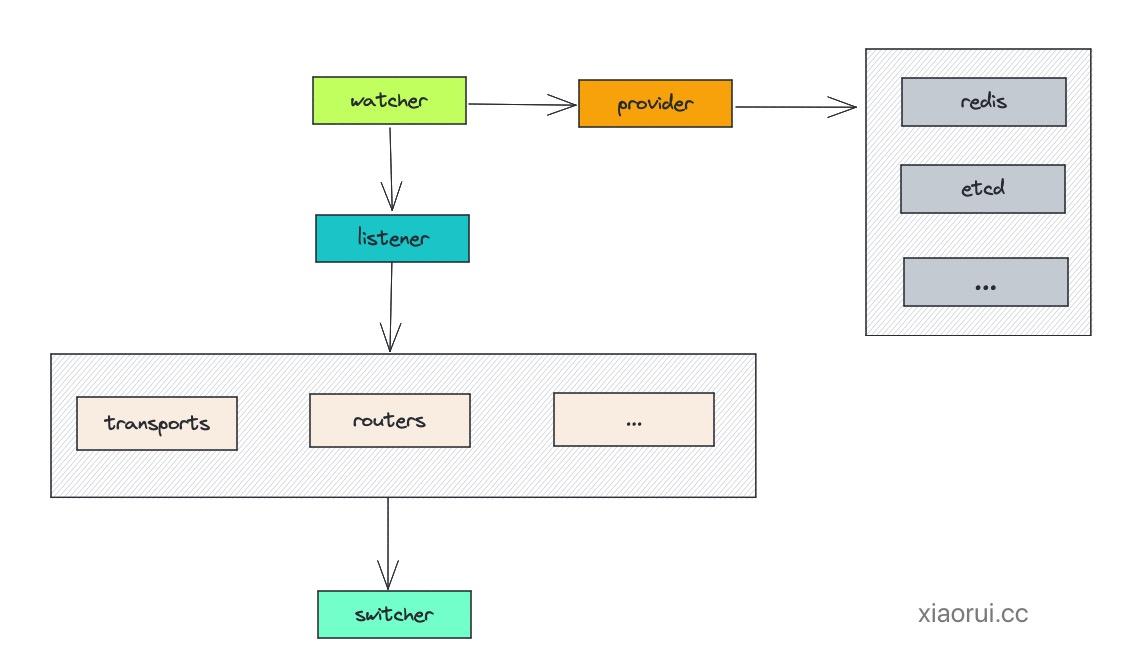

traefik 设计实现之配置的动态更新
source link: https://xiaorui.cc/archives/7290
Go to the source link to view the article. You can view the picture content, updated content and better typesetting reading experience. If the link is broken, please click the button below to view the snapshot at that time.
traefik 设计实现之配置的动态更新 – 峰云就她了
像 nginx 是支持配置更新,只是不支持动态的配置发现更新,需要外加插件才可以,不加插件只能手动改文件,然后通过 nginx -s reload 来更新,reload 的实现错误是 master 收到信号后重载配置,fork 新的 worker 子进程,最后优雅干掉老配置的 worker 子进程.
基于 openresty 的 kong 和 apisix 都是支持动态配置更新的.
traefik 是支持配置的动态更新,那么 traefik 作为高性能网关,如何在不影响业务的情况下,实现配置的动态更新 ?

通过分析代码后,得知动态更新主要依赖 watcher,listener, provider, switcher 设计来实现的,缺一不可呀. 😁
- watcher 动态配置的主逻辑,关联了 listener, provider.
- listener 实现具体配置在 traefik 里的更新.
- provider 实现发现配置及监听是否变更.
- switcher 抽象了 http.Handler, tcp.Handler 等逻辑,每次读取或变更时,都需要加锁以保证线程安全.
初始化阶段
首先 traefik 在 cmd 初始化阶段, 通过 setupServer 进行实例化 provider 和 watcher 对象.
func setupServer() {
...
// 根据 provider 类型做实例化 provider.
providerAggregator := aggregator.NewProviderAggregator(*staticConfiguration.Providers)
// 创建 watcher 监听和更新配置.
watcher := server.NewConfigurationWatcher(
routinesPool,
providerAggregator,
getDefaultsEntrypoints(staticConfiguration),
"internal",
)
...
}
watcher
watcher 实现了配置监听和更新的主逻辑,内会启动了三个协程.
- receiveConfigurations, 监听配置更新, 对比本地配置并发送通知
- applyConfigurations, 应用配置更新, 调用上层传递 listener 回调方法,使各个组件都被动更新
- startProviderAggregator, 调用 provider 的 provide 接口,传递一个 chan 和 协程池wg
// NewConfigurationWatcher creates a new ConfigurationWatcher.
func NewConfigurationWatcher(
routinesPool *safe.Pool,
pvd provider.Provider,
defaultEntryPoints []string,
requiredProvider string,
) *ConfigurationWatcher {
return &ConfigurationWatcher{
}
}
// Start the configuration watcher.
func (c *ConfigurationWatcher) Start() {
c.routinesPool.GoCtx(c.receiveConfigurations)
c.routinesPool.GoCtx(c.applyConfigurations)
c.startProviderAggregator()
}
// Stop the configuration watcher.
func (c *ConfigurationWatcher) Stop() {
close(c.allProvidersConfigs)
close(c.newConfigs)
}
// AddListener adds a new listener function used when new configuration is provided.
func (c *ConfigurationWatcher) AddListener(listener func(dynamic.Configuration)) {
if c.configurationListeners == nil {
c.configurationListeners = make([]func(dynamic.Configuration), 0)
}
c.configurationListeners = append(c.configurationListeners, listener)
}
switcher
switcher 这个名字起的有点怪,traefik 各个组件都有 switcher 的实现,比如 http 里的 switcher 实现了 http.handler 接口,tcp 的 switcher 实现了 tcp.handler 接口. switcher 本质就是 sync.Map + interface{} 组合,目的为了线程安全获取和动态更新 handler.
这样当每次请求需要处理时,都会从 switcher.safe 里加锁获取 http.Handler, 当 watcher 配置动态更新的时候,也是加锁的更新 http.Handler.
下面是 http switcher 的结构设计:
type HTTPHandlerSwitcher struct {
handler *safe.Safe
}
func NewHandlerSwitcher(newHandler http.Handler) (hs *HTTPHandlerSwitcher) {
return &HTTPHandlerSwitcher{
handler: safe.New(newHandler),
}
}
func (h *HTTPHandlerSwitcher) ServeHTTP(rw http.ResponseWriter, req *http.Request) {
handlerBackup := h.handler.Get().(http.Handler)
handlerBackup.ServeHTTP(rw, req)
}
func (h *HTTPHandlerSwitcher) GetHandler() (newHandler http.Handler) {
handler := h.handler.Get().(http.Handler)
return handler
}
func (h *HTTPHandlerSwitcher) UpdateHandler(newHandler http.Handler) {
h.handler.Set(newHandler)
}
listener
配置的动态更新是通过 listener 来实现的. traefik 里有不少动态更新,这里重点说下两个配置更新.
- server trasnports 连接池
- routers 路由匹配策略
server transports 连接池的更新
server transports 的监听器在当配置更新时,会对 RoundTripper 管理器加锁, 然后新建 transport 连接池, 老的池子不去管,因为 http 组件也是每次通过 Get() 实时获取的 roundTripper,在当前的请求都处理完毕后,http 就不会再复用引用这个要销毁的 RoundTripper, 后面依赖空闲超时 idleConnTimeout 去关闭连接.
// Server Transports
watcher.AddListener(func(conf dynamic.Configuration) {
roundTripperManager.Update(conf.HTTP.ServersTransports)
})
roundTripper update 的逻辑实现,先去除老的配置,并分析配置否是有变更,对于产生变更的新建连接池,对于新增的 transport 配置则直接新创建.
func (r *RoundTripperManager) Update(newConfigs map[string]*dynamic.ServersTransport) {
r.rtLock.Lock()
defer r.rtLock.Unlock()
for configName, config := range r.configs {
// 去除老的配置
newConfig, ok := newConfigs[configName]
if !ok {
delete(r.configs, configName)
delete(r.roundTrippers, configName)
continue
}
// 如果新旧配置相等, 则无需更新
if reflect.DeepEqual(newConfig, config) {
continue
}
var err error
// 对于有变更的配置,实例化新 roundTripper 连接池.
r.roundTrippers[configName], err = r.createRoundTripper(newConfig)
}
for newConfigName, newConfig := range newConfigs {
if _, ok := r.configs[newConfigName]; ok {
continue
}
var err error
// 对于没有的,实例化连接池
r.roundTrippers[newConfigName], err = r.createRoundTripper(newConfig)
}
r.configs = newConfigs
}
routers 路由规则的更新
关于 router 的监听器,当配置更新时,重新创建 tcpRouters 和 udpRouters 路由,然后分别在 tcp 和 udp 的 entrypoint 上做更新, 遍历更新到各个组件的 switcher 上,本质就是个加了锁的 value.
// Switch router
watcher.AddListener(switchRouter(routerFactory, serverEntryPointsTCP, serverEntryPointsUDP))
在 tcp 和 udp 上更新 routers.
func switchRouter(routerFactory *server.RouterFactory, serverEntryPointsTCP server.TCPEntryPoints, serverEntryPointsUDP server.UDPEntryPoints) func(conf dynamic.Configuration) {
return func(conf dynamic.Configuration) {
rtConf := runtime.NewConfig(conf)
routers, udpRouters := routerFactory.CreateRouters(rtConf)
serverEntryPointsTCP.Switch(routers)
serverEntryPointsUDP.Switch(udpRouters)
}
}
// Switch the TCP routers.
func (eps TCPEntryPoints) Switch(routersTCP map[string]*tcprouter.Router) {
for entryPointName, rt := range routersTCP {
eps[entryPointName].SwitchRouter(rt)
}
}
// SwitchRouter switches the TCP router handler.
func (e *TCPEntryPoint) SwitchRouter(rt *tcprouter.Router) {
...
httpHandler := rt.GetHTTPHandler()
...
e.httpServer.Switcher.UpdateHandler(httpHandler)
rt.SetHTTPSForwarder(e.httpsServer.Forwarder)
...
httpsHandler := rt.GetHTTPSHandler()
e.httpsServer.Switcher.UpdateHandler(httpsHandler)
e.switcher.Switch(rt)
e.http3Server.Switch(rt)
}
provider
provider 是用来实现监听配置的动态更新以及获取变更通知的。逻辑相对简单,就是监听配置是否有变更,当发生变更后,通知给 watcher, watcher 在把事件传递给一个个的 listener 做具体的配置变更.
比如可以把配置的放到 etcd 上,当在 etcd 上做了更新后,通知给 traefik 做变更. traefik 实现了不少 provider,有本地文件、docker、etcd、redis、consul、http、 k8s crd 等.
file provider 实现
基于文件的 provider 的实现,源码还是简单的. 首先需要实现 Provide 接口,该方法通过 inotify 来监听文件的更新事件,当发生变动时,会通知给上层传递的 configurationChan chan<- dynamic.Message 通道.
func (p *Provider) Provide(configurationChan chan<- dynamic.Message, pool *safe.Pool) error {
configuration, err := p.BuildConfiguration()
if err != nil {
return err
}
if p.Watch {
var watchItem string
...
if err := p.addWatcher(pool, watchItem, configurationChan, p.watcherCallback); err != nil {
return err
}
}
sendConfigToChannel(configurationChan, configuration)
return nil
}
func (p *Provider) watcherCallback(configurationChan chan<- dynamic.Message, event fsnotify.Event) {
sendConfigToChannel(configurationChan, configuration)
}
func sendConfigToChannel(configurationChan chan<- dynamic.Message, configuration *dynamic.Configuration) {
configurationChan <- dynamic.Message{
ProviderName: "file",
Configuration: configuration,
}
}
kv provider 实现
traefik 使用 github.com/kvtools/valkeyrie 实现常见 kv 存储的读写接口, 所以在 traefik 看不到各类 kv 数据库读写实现. kv provider 的实现跟 file provider 大同小异.
// Provide allows the docker provider to provide configurations to traefik using the given configuration channel.
func (p *Provider) Provide(configurationChan chan<- dynamic.Message, pool *safe.Pool) error {
configuration, err := p.buildConfiguration(ctx)
if err != nil {
} else {
configurationChan <- dynamic.Message{
ProviderName: p.name,
Configuration: configuration,
}
}
pool.GoCtx(func(ctxPool context.Context) {
err := p.watchKv(ctxLog, configurationChan)
})
return nil
}
func (p *Provider) watchKv(ctx context.Context, configurationChan chan<- dynamic.Message) error {
operation := func() error {
events, err := p.kvClient.WatchTree(ctx, p.RootKey, nil)
for {
select {
...
case _, ok := <-events:
configuration, errC := p.buildConfiguration(ctx)
if configuration != nil {
configurationChan <- dynamic.Message{
ProviderName: p.name,
Configuration: configuration,
}
}
}
}
}
...
return nil
}
traefik 的动态配置更新是由 watcher,listener, provider, switcher 组合实现的.
- watcher 动态配置的主逻辑,关联了 listener, provider.
- listener 实现具体配置在 traefik 里的更新.
- provider 实现发现配置及监听是否变更.
- switcher 抽象了 http.Handler, tcp.Handler 等逻辑,每次读取或变更时,都需要加锁以保证线程安全.
traefik 源码抽象的好,组合起来也顺,但分析源码时还是有些绕的,每个单元看起来都好懂,反而衔接起来反而不易懂。
Recommend
About Joyk
Aggregate valuable and interesting links.
Joyk means Joy of geeK
